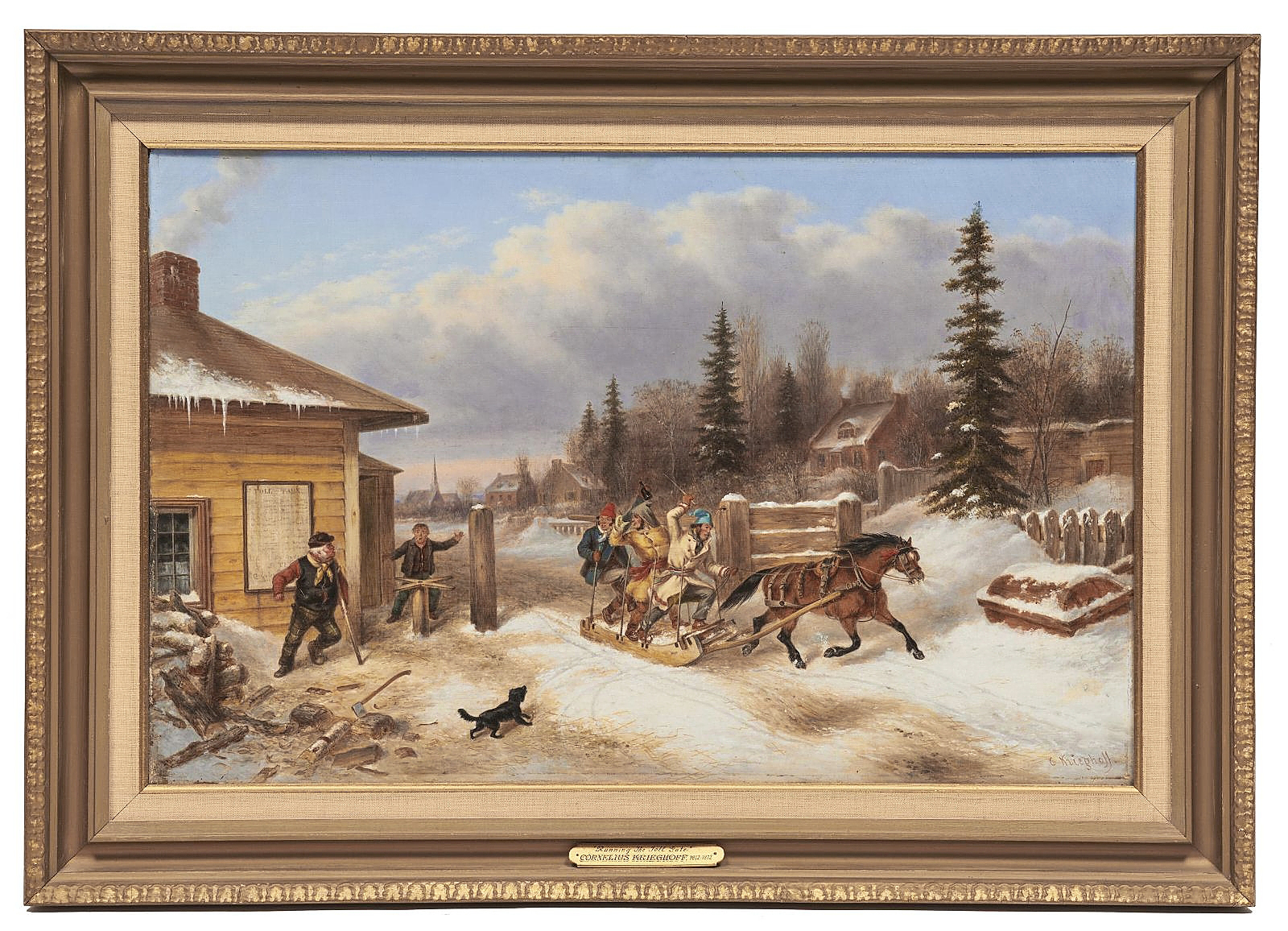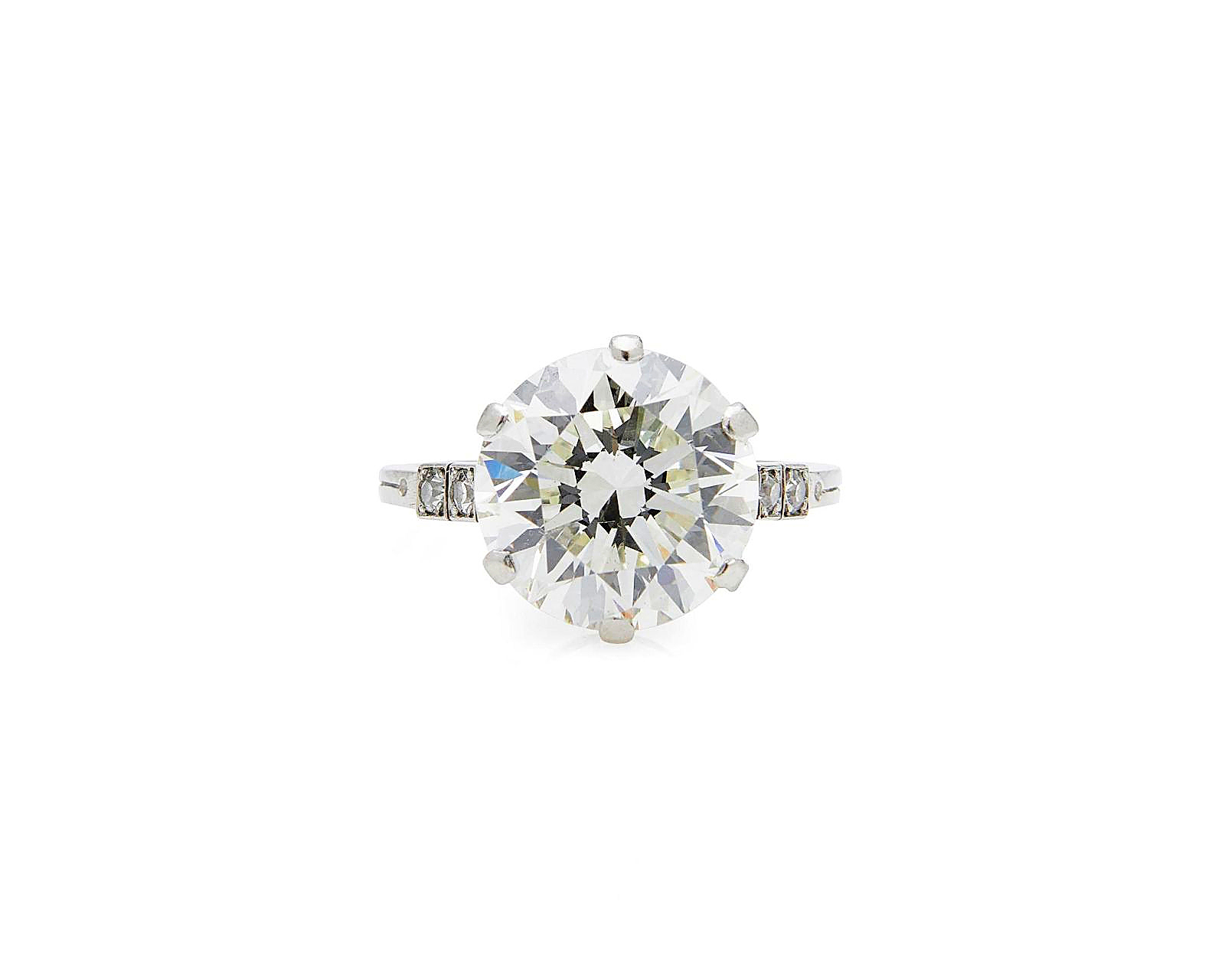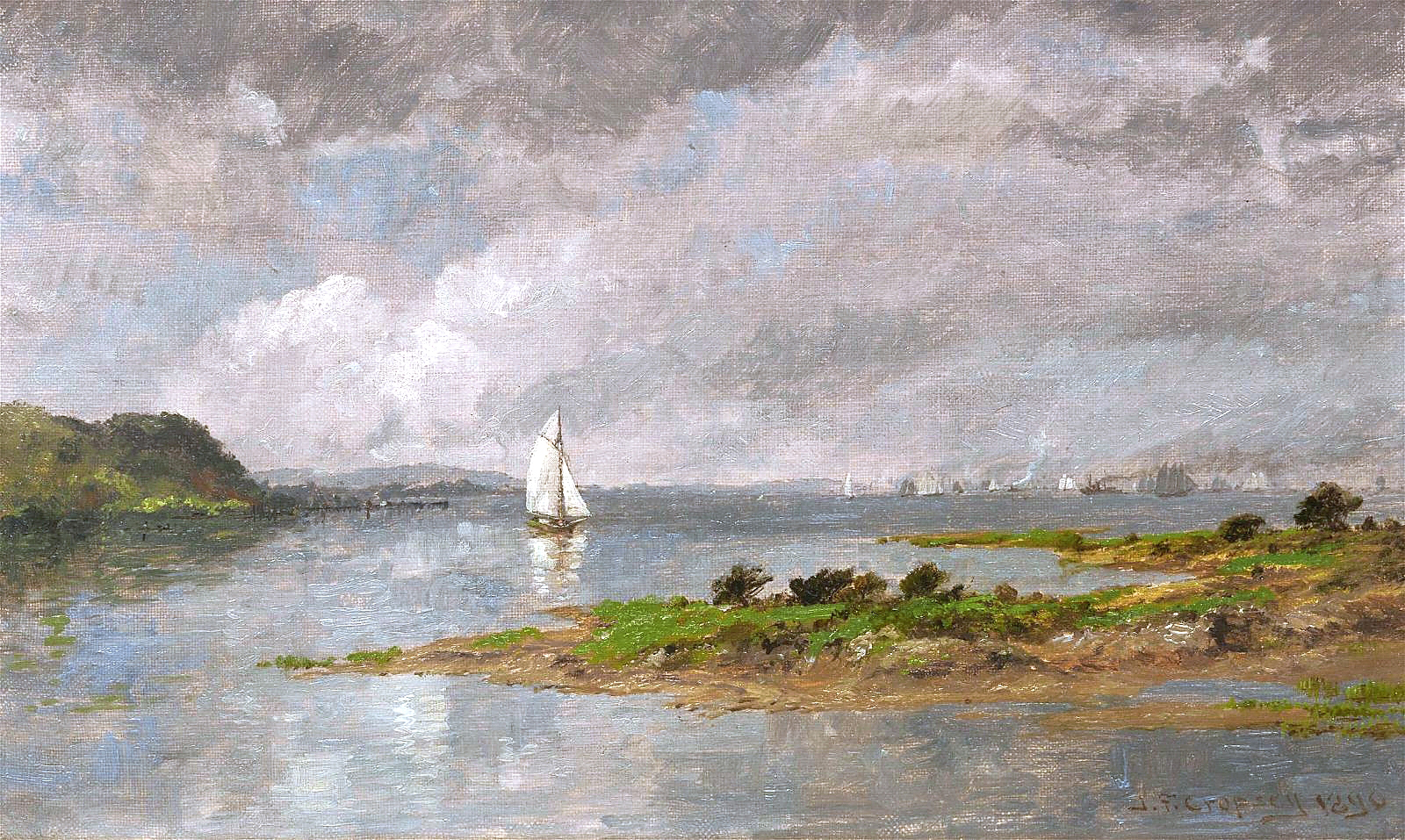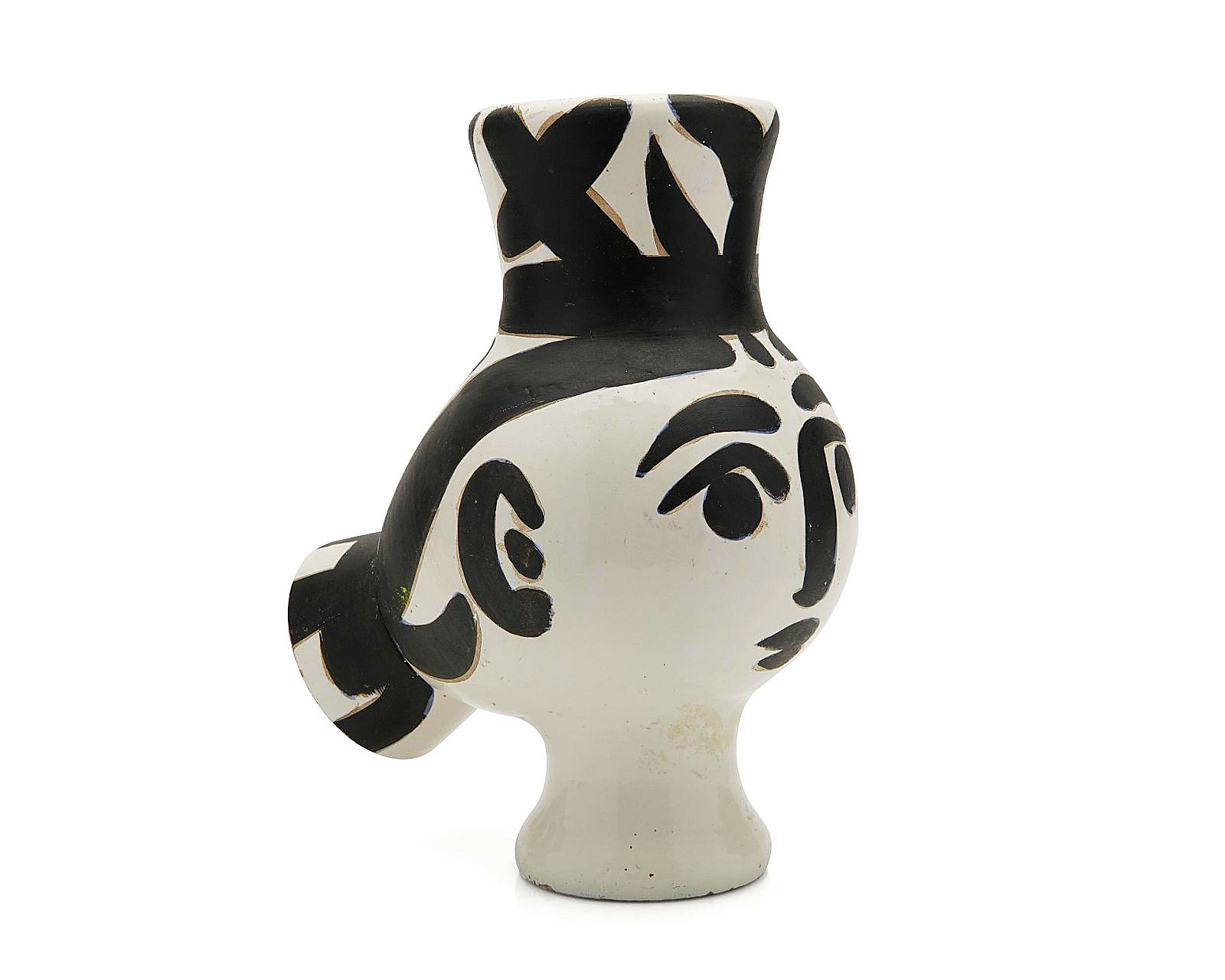
“Running The Toll Gate” by Canadian artist Cornelius David Krieghoff, one of about 30 variations the artist painted, realized $212,500, the highest priced item in the two-day auction event; it will be returning to Canada.
Review & Onsite Photos By Rick Russack, Catalog Photos Courtesy Grogan & Co
BOSTON — Fine art was sold on the first day of Grogan & Co’s two-day auction, May 6-7, and it was led by “Running the Toll Gate,” a circa 1863 painting by C.D. Krieghoff, which sold for $212,500. Fine jewelry sold on the second day and was led by an $87,500 platinum and diamond ring. There were several works by painters of the Rockport, Mass., school, and works by such notables as Maurice Prendergast, Marguerite and William Zorach, Milton Avery, Andy Warhol and Roy Lichtenstein. Jewelry offerings included several diamond pieces, as well as ruby, emerald and natural pearl pieces, along with designer pieces. More than two dozen paintings — of more than 150 on offer — brought five figure prices. The similarly sized jewelry auction also saw two dozen pieces of jewelry achieving five-figure prices, with detailed condition reports included for most items.
The company’s new president, Georgina Winthrop, who has been with Grogan since graduating from Harvard in 2014, believes that the two-day format, without live-in-the-gallery bidding, works well for the company and will stick with that. There will probably be two such sales a year. One-day specialty sales will be interspersed.
Winthrop is also the fine art director and, prior to the sale, was very enthusiastic about the action-packed “Running the Toll Gate” composition by Canadian artist Cornelius David Krieghoff (1815-1872). The artist is known to have painted about 30 variations of the scene but few remain in private hands; this is only the second example to come up at auction in the past 25 years. The scene shows a horse pulling a sled with three men, one of whom is thumbing his nose at the gatekeeper, a toll house and other buildings, a small dog and the open gate. It’s a winter scene; the horse’s breath is depicted, and there’s a woodpile with an axe nearby.

The star of the jewelry offerings was a platinum and diamond ring which realized $87,500. The round brilliant-cut diamond weighing 6.04 cts. was flanked by six full-cut diamonds weighing 3.45 dwts.
A brief excerpt from the catalog states that “Krieghoff carefully considered each detail in his work, precisely rendering elements ranging from the construction of the horse-drawn worksleigh to the color of the villagers’ sashes. Although it is the figures that bring action to the composition, Krieghoff still documents the everyday aspects of the toll, including the snow-roller at right (not recently used, as evidenced by the potholes in the foreground), and the tariff board on the toll-building at left. Meanwhile, the aggrieved toll-keeper leans toward the villagers, his jaw set, and his fist clenched in frustration.”
The sale offered a second work by Krieghoff: an oval scene of a canoe being paddled through rapids in a forested landscape that sold for $21,250.
“Barn at the Edge of the Woods III,” a 1973 work by Wolf Kahn (American, 1927-2020) sold for $75,000, the second highest priced artwork in the sale. It was an unusual use of color by the artist, as Winthrop explained during the preview. Prior to this time, Kahn worked with muted colors, but with this painting he moved to much brighter colors. The entire foreground depicts goldenrod in bloom, so it is a bright yellow and the trees, in autumn colors, are bright purple. The painting had remained in the family of the original purchaser since 1973.
There were four works by either Marguerite (American, 1887-1968) or William Zorach (American, 1887-1966). Her fauvist depiction of a flower market in France earned $62,500. “Father and Son,” a terracotta study for William’s sculpture “Faith of the Nation is Eternal” was one of only four known, and sold for $2,375. Its provenance included Edith Halpert’s Downtown Gallery and Laurance Rockefeller. Of two watercolors by the artist, “Coming Storm” earned $4,375, while “Mountain Stream” realized $4,063.
“A Rosy Dawn” by American Impressionist John Joseph Enneking (1841-1916) was another painting that Winthrop felt reflected a change in the colors normally used by the artist. Signed and dated 1902 and selling for $25,000, the autumn landscape utilized shades of pink, a color not normally associated with the artist. Another painting by the artist, “Looming Clouds,” went out for $4,063.

“On the Hudson,” an 1890 oil on canvas by Jasper Francis Cropsey, depicted a sailboat on the river. It is listed in the artist’s catalogue raisonné and sold for $23,750.
“Italian Fishing Boats, Gloucester,” by Hayley Lever (American, 1876-1958) was one of the most sought-after of the works by Cape Ann artists realizing $25,000. Frederick Mulhaupt’s (American, 1871-1938) “Atlantis Wharf, Gloucester, Mass.,” also did well, earning $17,500. Three winter landscapes by another of the Cape Ann artists, Aldro Thompson Hibbard (1886-1972) sold in the $3,500 to $5,000 range. There were four works by William Lester Stevens (American, 1888-1969); the highest price for any of his works was $3,750.
As previously mentioned, the jewelry category was led by two platinum and diamond rings, one of which realized $87,500. It had a round brilliant-cut diamond weighing 6.04 carats, which was flanked by six full-cut diamonds weighing 3.45 dwts. It was accompanied by a GIA certificate stating the diamond to be J, SI1. The second ring, earning $53,125, centered an emerald-cut diamond weighing 3.84 carats, flanked by two bullet-cut diamonds weighing 3.18 dtws; it also was accompanied by a GIA report. Bringing the same $53,125 price was a Ross Pennell platinum, Burmese ruby, seed pearl and diamond necklace. It had a floating oval briolette-cut Burmese ruby weighing approximately 6.30 carats framed by full-cut diamonds. Its AGL report stated that it was a Burmese ruby with no evidence of heat.
There were two ballerina brooches designed by Charles Julius Bahruth that had both descended within Bahruth’s family. He had apprenticed with both Tiffany and Cartier, but the ballerinas, which were a popular form, were designed when he worked for the John Rubel Company in New York during World War II. Both were 18K gold; one, with diamonds, rubies and sapphires, brought $15,000. The other, with the same stones as well as opals, brought $11,250. Grogan’s jewelry director, Taylor See’s catalog description, has more information on Bahruth. Grogan does well with brooches and another, in the form of a butterfly in 14K and 18K gold, along with diamonds, rubies, pearls and emeralds, earned $7,500. The same price was achieved by a platinum-topped-gold, diamond and colored diamond flower-form brooch despite some condition issues.

This 1950 glazed earthenware vase designed by Picasso, “Chouette Femme, (Owl Woman),” stamped and marked “Edition Picasso” and stamped “Madoura Plein Feu” on the base brought $10,938.
See was enthusiastic about three pieces with natural pearls. A pair of Belle Epoque platinum and diamond earrings with suspended natural pearls reached $10,000. Earning $8,125 was a set of gold, silver and diamond ear clips, with a matching brooch, each with natural pearls. In all there were 134 lots of jewelry, more than a dozen watches, including some made by Cartier, Patek Phillipe, Paget and Rolex, and three Hermes scarves. All but six pieces of jewelry sold.
After the sale, Michael Grogan, the company’s founder, said, “It went well. We’re always pleased with a $2 million sale. We’re concentrating on expanding our retail base and I was glad to see the amount of private interest. We had two Canadian bidders on the phone — one a dealer and one a collector — for “Running The Toll Gate,” which will be going back to Canada. Our catalog is starting to show some of the jewelry being modeled by Taylor See, so that prospective bidders can see the scale of a ring or necklace or other item and we’re using more photographs of each item. Personally, I’m very pleased with Georgina’s new role as president of the company. She’s running the day-to-day nitty-gritty of the business and that leaves me more time to work with collectors and prospective consignors — which is what I really love to do. We work well together. Clients really like Taylor and she’s getting some very good jewelry for upcoming sales. Our next sale will be a significant single-owner collection of Chinese export porcelain and we’re scheduling that for August. The collectors, two brothers, have bought from us over the years and are well-known in that sphere.”
All prices quoted include the buyer’s premium as reported by the auction house. For more information, 617-720-2020 or www.groganco.com.




























